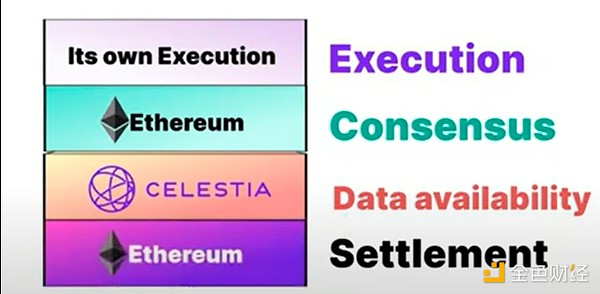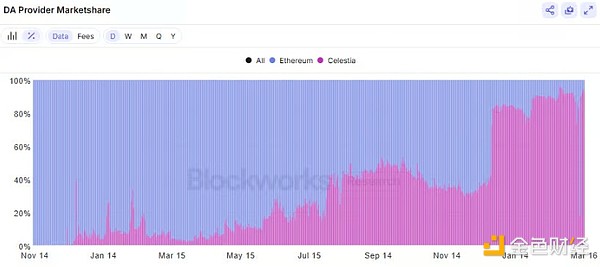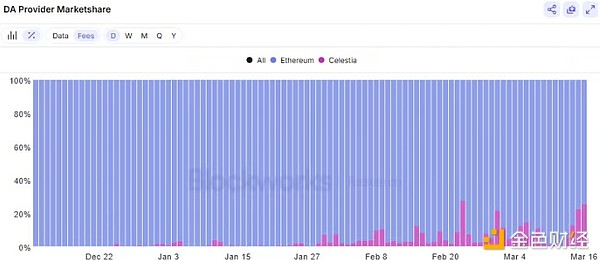Betting on Celestia is a bet on web3 scaling (the expansion of blockchain at the scale of websites) and a hedge against Ethereum and its ability to successfully execute the L2 roadmap.
Written by: Michael Nadeau, The DeFi Report
Translated by: Deng Tong, Jinse Finance
In this report, we will narrow our focus to compare the construction of today's Ethereum with the construction of the internet, while introducing Celestia—an attempt to disrupt Ethereum and become the default data availability (DA) solution serving Ethereum L2 and sovereign rollups.
Challenges of Ethereum
Ethereum's scaling roadmap presents two major obstacles for investors to overcome that did not exist in the 21st-century cycle:
- The influx of L2 tokens over the past few years has diluted the amount of venture capital that can flow into ETH as a long-term investment.
- From an execution perspective, L2 has improved the underlying technology of Ethereum's base layer, leading to a significant portion of its economy shifting to L2.
From an investor's perspective, a report released by Standard Chartered this week helps to understand this outcome—they estimate that Base has taken $50 billion in market cap from Ethereum L1. As a result, Standard Chartered has lowered its year-end price target from $10,000 to $4,000.
Given Ethereum's lack of scalability at the L1 layer, it must be able to serve L2, as L2 is its primary customer for the future.
Ethereum currently holds this market. However, looking ahead, competitive threats are emerging.
To fully understand what is happening, we want to narrow our focus to compare the construction of Ethereum with the construction of the internet itself. Articulating this first will help clarify the challenges Ethereum currently faces.
Then, we will introduce Celestia's value proposition—which we will detail later in the report.
Early Internet
- In the early days of web development, if you wanted to create a website, you had to host your own physical server—this was expensive and not scalable.
- We solved this problem by creating shared server hosting. By utilizing hosting services like GeoCities, it became easier and cheaper to build websites.
- The internet began to scale, and it became cheaper for entrepreneurs to build websites that offered products and services.
- Eventually, innovation was limited by the shared execution provided by GeoCities. The emergence of virtual servers—offering the scalability of your own server + customization/flexibility, but with the convenience of using shared hosting—gave birth to Amazon Web Services.
- With the advent of AWS, e-commerce, SaaS companies, and social media also emerged—all of which were impossible to achieve in the early days of internet development.
Today, a similar process is unfolding on public blockchains—they introduce a new data structure to the internet through global ledgers and digital ownership.
It starts with a cumbersome, inefficient, and expensive user experience, then becomes streamlined, cheap, and fast.
Public Blockchains and Ethereum
- Bitcoin was the first public blockchain. In the early days of web3, if you wanted to leverage this groundbreaking new technology to create new applications, you had to start from your own blockchain. Bitcoin's forked coins (peer-to-peer naming system) are an early example. This era of public blockchains is similar to the early web—when you had to host your own server to build a website.
- Ethereum emerged in 2015. We can think of L1 as "the GeoCities of web3." Why? Ethereum allows developers to launch applications using shared infrastructure. There is no need to launch your own chain and bootstrap validators. This is similar to GeoCities, which allowed developers to build websites without hosting on their own servers.
- Of course, developers need more throughput and flexibility to build specialized use cases. Enter Ethereum L2s—execution environments built "on top" of L1, with Ethereum serving as the infrastructure for data availability and security.
- Now, Ethereum is starting to look like a "network of networks"—similar to the construction of the internet itself.
- However, there are still some challenges. In particular, the DA costs of Ethereum remain quite high. This opens the door for competitors like Celestia to serve Ethereum's L2 customers, similar to how AWS serves web2 applications in the current cloud era.
Now, given Celestia's early success, we have to ask a question: Does Celestia pose a threat to Ethereum's L2 roadmap?
What happens if Ethereum L2 turns to solutions like Celestia?
Introduction to Celestia
Celestia is a proof-of-stake blockchain (currently with 100 validators) specifically designed to solve the problem of data availability verification—previously, verification required nodes to download all transactions in a block. They solved this problem through data availability sampling—ensuring data availability without requiring nodes to download the data.
Their target customers are other blockchains.
Now, suppose you are Robinhood. Your platform has over 20 million users trading stocks and options each month. Meanwhile, cryptocurrency trading has become an important part of your business (35% of Q4 revenue).
Suppose you decide to further integrate into the cryptocurrency infrastructure because you see that all assets will be tokenized for trading and settlement/accounting in the future.
Naturally, you decide that the best way to maximize value while maintaining control and flexibility is to build L2 on Ethereum (which has the best network effects in cryptocurrency).
You need the following components to make it all work:
- Execution: Handling transactions, swaps, payments, and other user operations
- Consensus: Ensuring no one cheats and everyone follows the same rules (think of consensus as security)
- Data Availability: Making the historical record (data) of what happened available for others to audit or for other applications to access
- Settlement: Final accounting/scorekeeping
If you are Robinhood, you would want to build your own sovereign L2 where you can control execution. However, you might not want to build your own validator network for consensus/security. Perhaps you would use Ethereum for that.
Of course, you need to make all your data available for others to audit/verify and for other applications to access. You could also use Ethereum for that. But Celestia is 100 times cheaper + it allows you to integrate with other L2s and even with Solana (in the future) to provide your data there.
Maybe you choose Celestia as your DA layer.
Finally, you need a place to resolve all user activity as a "final scoreboard." Given Ethereum's security, decentralization, and Lindy effect, you choose it as your official accounting ledger.
This is your tech stack:

What Problems Does Celestia Solve for Robinhood?
Celestia enables Robinhood to more easily execute the following:
- Have its own execution environment.
- Leverage Ethereum for consensus and settlement—this is what Ethereum excels at as the most secure and decentralized L1.
- Utilize Celestia for data availability, at a cost much lower than using Ethereum (currently 100 times cheaper).
- In the future, if Celestia can build an L2 network (with native bridging), leveraging it for data availability, then Robinhood can benefit from providing access to its data to everyone in that network. Additionally, if Celestia can connect L1 in a native, seamless experience (which is not an easy task), Celestia could even provide access to its data for applications and users on other chains.
Key Points:
- When discussing the composability of DeFi applications, you may have heard the term "money Legos." Celestia aims to provide this experience for sovereign rollups that wish to customize their tech stack while making data usable across various chains/applications/execution environments.
- L1 currently achieves network effects through shared standards (tokens, smart contracts, development tools, etc.). Celestia seeks to create network effects between L1 and L2 as a key "middleware" protocol in the web3 tech stack. This is a great idea. Its goal is to create network effects through "blob fees" as the "default DA solution"—the standard that all L2s will choose when using Celestia. Due to its composability with other rollups and L1, this could give it a "moat"—solving the fragmented liquidity and user base between L1 and L2. Again, this is a great idea, but not an easy task.
- To succeed, it needs to attract the largest L2s as customers (currently it does not) and become the default choice for all newcomers.
- Robinhood (and existing L2s) may prefer to stick with Ethereum rather than Celestia for many reasons.
Security Risks. Ethereum assumes that DA and settlement are unified when validating rollups. If Robinhood publishes data to Celestia but settles on Ethereum, Ethereum cannot natively verify Celestia's DA guarantees. This increases the trust assumptions for Ethereum validators, who must rely on Celestia's external monitoring.
Additional Complexity. Blobs are directly built into Ethereum's protocol, making them easier to implement and maintain.
Risk vs. Reward. Ethereum is currently the most decentralized and secure smart contract network. In this emerging stage, choosing a less mature alternative may be seen as high risk, low reward.
Adoption of Celestia
As mentioned earlier, Celestia needs to attract the largest and most successful rollups + most newcomers. Why? It needs to attract the largest customers and then connect them all—creating a seamless user experience for future builders who want to access users and data across all chains while allowing anyone to verify the data.
If this momentum is achieved, Celestia (as middleware connecting all chains through data availability) could become one of the most important protocols in web3 (similar to Bitcoin, Ethereum, and Solana).
Of course, there is still a long way to go.
Current Progress
Celestia has been around for less than 1.5 years. However, it has already become the leading DA solution in the crypto space, currently holding a 90% market share in terms of the volume of data published.

Top Customers
- General L2: 86.7% (Eclipse, Solana Virtual Machine (SVM) L2 constitutes the vast majority of data published to Celestia today)
- Gaming L2: 2.8%
- Financial L2: 1.7%
- Social L2: 0.5%
- Consumer L2: 0.12%
A total of about 30 rollups are currently publishing data to Celestia. It secures approximately $500 million in value.
As mentioned earlier, Celestia has yet to secure one of the top Ethereum L2s to utilize it for DA. We believe their goal is to get top L2s to move, thereby becoming the "default DA solution" for newcomers. From there, they can achieve network effects and a "moat" around a new standard centered on "blob fees"—enabling cross-chain composability.
That said, we believe that L2s like Base, Arbitrum, and Optimism have little incentive to leave Ethereum today.
Celestia's Business Model and Fees

While Celestia holds about 90% of the market share in data publishing, it only holds 25% of the market share in fees (because costs are lower than Ethereum). Currently, its daily fees are around $20,000 to $25,000.
Fees are set as low as possible to prevent spam. The goal is to form network effects today and control pricing power in the future.
Ultimately, Celestia's pricing power will come from its network effects as a unified standard for L2 and L1. Without network effects, there is no pricing power.
Addressable Market
Everything is about economies of scale. Celestia's addressable market includes all Ethereum rollups, sovereign application chains, and potential L2s settling to Solana or other L1s.
Ultimately, Celestia believes the number of chains could exceed the number of websites.
Its goal is to charge about 1/10 of a cent for high-volume transactions.
Will Celestia Become the "AWS of Web3"?
Just as AWS facilitated the proliferation of web applications by handling heavy servers and scalability, Celestia can promote the proliferation of customized blockchain applications by managing large-scale data availability.
With Celestia, developers can deploy their own chains (rollups or sovereign chains) without needing to recruit hundreds of validators or invent new consensus protocols. This is similar to how startups use AWS to launch cloud servers instead of purchasing physical servers.
The end result of Web2 was a significant reduction in the barrier to entry. Therefore, Celestia believes that if web3 use cases can achieve network effects, it could become the default solution for developers needing a customized web3 stack, significantly expanding its potential market.
AWS had a tremendous impact on the proliferation of websites and applications on the internet by eliminating infrastructure barriers and reducing costs.
Celestia seeks to provide the same support for the proliferation of rollups and sovereign blockchains.
Summary
The internet is composed of a series of decentralized protocols that ultimately enable global information (data) sharing, allowing one computer to access everything in the world.
But this did not happen overnight. It was a process of combining key protocols (like TCP/IP, HTTP, DNS, etc.) with tools like AWS, which ultimately created today's internet.
In many ways, web3 is being built in a similar decentralized manner.
Ultimately, there needs to be a "connective tissue" for cross-chain and data to provide a user experience in web3 similar to what we have in web2.
Celestia hopes to become this "connective tissue."
They are betting on an optimistic future where developers will want the unbounded flexibility to build web3 applications while allowing everyone access to data.
We believe they may have found the solution today.
But technology alone is not enough. They need to create significant network effects between L2 and L1 through cross-chain composability to realize this vision.
This is no easy task.
However, given the current valuation, potential market, team, supporters, early lead, and the lack of competition in today's market (excluding Ethereum), we believe Celestia is best positioned to address this challenge.
Ultimately, we believe that betting on Celestia is a bet on web3 scaling (the expansion of blockchain at the scale of websites) and a hedge against Ethereum and its ability to successfully execute the L2 roadmap.
免责声明:本文章仅代表作者个人观点,不代表本平台的立场和观点。本文章仅供信息分享,不构成对任何人的任何投资建议。用户与作者之间的任何争议,与本平台无关。如网页中刊载的文章或图片涉及侵权,请提供相关的权利证明和身份证明发送邮件到support@aicoin.com,本平台相关工作人员将会进行核查。




